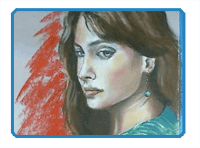
By Matt Fussell
Portrait drawing is one of the most traditional forms of art. After all, there is no better subject than ourselves, and the people we know. When working with color, pastels are often a popular choice for this subject matter. The immediacy of the pastel medium allows for quick build-up of color and depth. Adjustments in a drawing can be made easily and drawings can be developed quickly.
There are two major things to get right when drawing a portrait with pastels. The first is to understand the proportions of the human face and to draw them accurately. If the facial proportions are off, then the portrait will definitely suffer. Unless, of course the intent is to distort the proportions in the first place.
Without getting too detailed about the proportions of the human face (more here), there are a few things to consider. First, the eyes are found in the middle of the head. Sometimes, people mistakenly place them too high up on the face. It may help to draw a line in the middle of the head and place the eyes on this line. The nose found half-way between the eye line and the bottom of the chin and the mouth is generally just a little above half-way between the bottom of the nose and the chin.
The second thing to get right when drawing a pastel portrait is the medium. Pastels, when used without proper knowledge of how the medium works, can be frustrating. Proper use of pastels requires layering, blending, and mixing. New artists sometimes don't realize just how much layering is required for success, so they become easily frustrated. Pastels, although decidedly a drawing medium, are very closely related to painting. In fact, many refer to pastel drawings as paintings. So approaching a drawing with pastels, should be approached with a mind set of painting.
The following video features excerpts of two 1 hour Live Lessons in which a pastel portrait is demonstrated...
Here are some more art lessons that you may like...